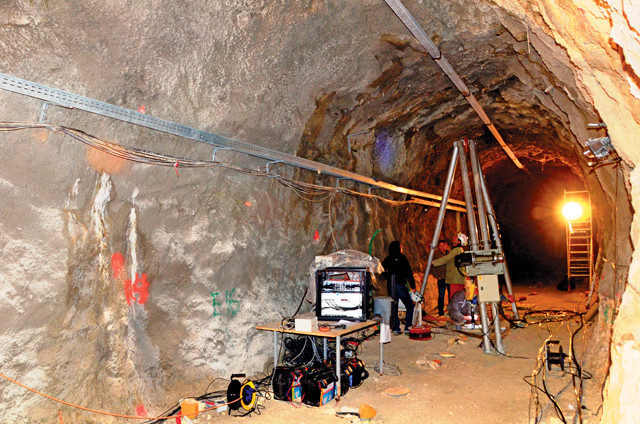
by Timothy Oleson Wednesday, September 2, 2015

Researchers deployed a new sensor to study the influence of fluid injection on a fault from a tunnel that is part of an underground research facility in southeastern France. Credit: Yves Guglielmi.
Scientists have known since the late 1960s that injecting fluids underground can cause earthquakes if those fluids find their way into slip-prone fault zones. Evidence of fluid-induced quakes has continued mounting in recent years with observations of abnormally high levels of seismicity in the central U.S., coincident with increased injections of wastewater into the ground — mostly related to oil- and gas-mining operations. But understanding the inner workings of fluid-filled faults is challenging because researchers have been limited by how close they can get to study them. Now, a new study is offering a glimpse into the future of induced-seismicity studies by monitoring fault motions on the spot and in real time.
From a tunnel hundreds of meters below ground in southeastern France, researchers drilled a vertical borehole intersecting a fault that cuts through the local limestone. They then deployed a newly designed instrument to detect subtle 3-D motions on the fault as well as to monitor fluid pressures. The two ends of the probe — fastened to the inside of the borehole on either side of the fault surface — are connected by flexible fiber-optic cables that act as motion sensors and allow the ends to move independently as the sides of the fault slide against one another. Once in place, the probe was sealed in a 1.5-meter-long portion of the borehole into which the scientists could pump water. “When we increase the [water] pressure in the chamber, the fluid diffuses into the fracture. … And what we measure is the relative movement of one wall of the fracture to the other,” explains Yves Guglielmi, a geophysicist at the European Center for Research and Education in Environmental Geosciences in France, and lead author of the new study published in Science.
After securing the sensor in place at a depth of 282 meters, Guglielmi and his colleagues injected 950 liters of water into the fault over the course of about 23 minutes, gradually increasing the injection rate. After several minutes, as the water pressure in the fault rose, they observed that the two sides of the fault slowly began to separate, or dilate, and also creep past one another a fraction of a millimeter at a time.
In an earthquake, the slip between two sides of a fault is sudden, rapidly deforming the surrounding rock and generating seismic waves. In the experiment, the initial movement was aseismic, meaning it did not produce any seismic waves. However, about 18 minutes into the experiment, the dilation slowed, the fault started slipping faster, and dozens of microearthquakes began popping off.
The microquakes — each with a magnitude of about minus 4, and only perceptible to other sensors stationed in nearby monitoring boreholes — appeared to occur outside the portion of the fault pressurized by the diffusing water, Guglielmi says. This observation raises questions about where the microquakes actually occurred — whether they were on, or perhaps off, the fault — and what mechanism, if not the fluid injection, actually caused the quakes, he says. Although explanations for these questions are lacking so far, he and his colleagues noted that it’s clear the microquakes are “an indirect effect” of the fluid injection, and one that is “mediated by aseismic creep.”
The study offers a new vantage on “the physical processes that happen on a fault as it begins to slide,” says Bill Ellsworth, a seismologist at the U.S. Geological Survey in Menlo Park, Calif., who was not involved in the study. “We typically study earthquakes remotely without being in the source zone,” or in the laboratory where high-pressure, high-temperature conditions can be replicated but where the scale is much smaller than on real faults, he says. “This provides an experimental window that goes beyond what we can do in the laboratory.”
That most of the movement observed during the experiment was aseismic isn’t surprising in itself, Ellsworth says, because of the relatively shallow depth and low pressure holding the fault together; such factors tend to promote slow creep along faults rather than the jarring stick-slip behavior of earthquakes. Natural earthquakes — on the San Andreas Fault for example — are rarely observed above 3 kilometers depth, he notes. The experiment’s shallow depth also suggests the results aren’t directly applicable to understanding and mitigating induced seismicity related to industrial wastewater, most of which is injected to depths greater than a kilometer.
“What’s of real interest is the technology that they used,” Ellsworth says, adding that it’s the first time anyone has tracked deformation on a fault during fluid injection. The technique “will be of great interest to scientists as they begin to contemplate doing deeper experiments.”
Indeed, the long-term goal is to send the new probe to “kilometer-scale depths, to explore faults and to see if there is a difference” in their behavior when the pressures on the faults are higher, Guglielmi says. For now, he and his colleagues are continuing to test shallow faults cutting through other rock types such as shale and granite. And so far, he says, these faults’ behavior seems consistent with the French limestone fault, but “it’s a little early” to draw any conclusions.
© 2008-2021. All rights reserved. Any copying, redistribution or retransmission of any of the contents of this service without the expressed written permission of the American Geosciences Institute is expressly prohibited. Click here for all copyright requests.